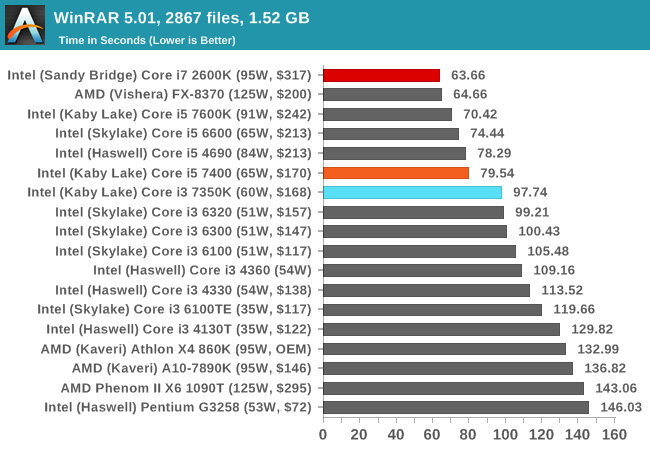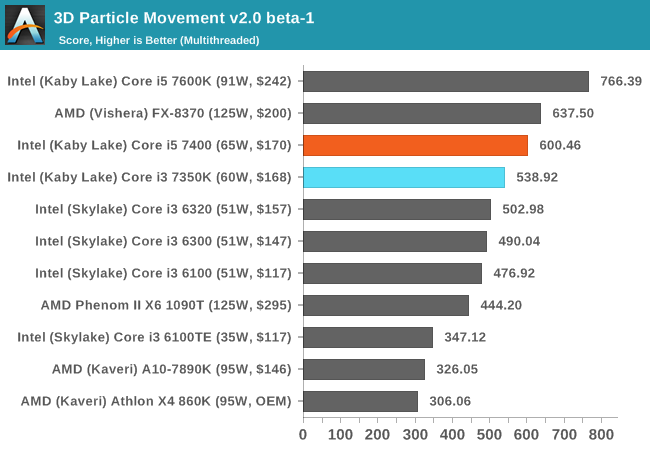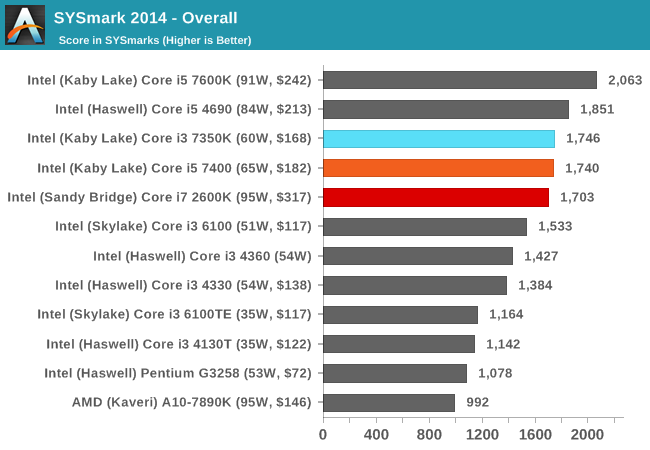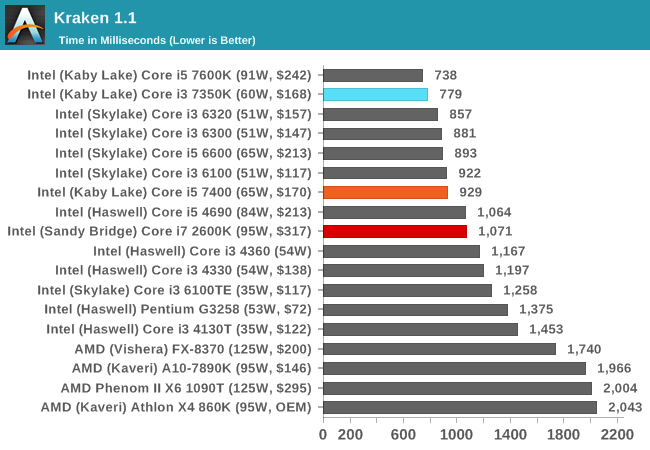The Intel Core i3-7350K (60W) Review: Almost a Core i7-2600K
by Ian Cutress on February 3, 2017 8:00 AM ESTOffice Performance
The dynamics of CPU Turbo modes, both Intel and AMD, can cause concern during environments with a variable threaded workload. There is also an added issue of the motherboard remaining consistent, depending on how the motherboard manufacturer wants to add in their own boosting technologies over the ones that Intel would prefer they used. In order to remain consistent, we implement an OS-level unique high-performance mode on all the CPUs we test which should override any motherboard manufacturer performance mode.
All of our benchmark results can also be found in our benchmark engine, Bench.
Dolphin Benchmark: link
Many emulators are often bound by single thread CPU performance, and general reports tended to suggest that Haswell provided a significant boost to emulator performance. This benchmark runs a Wii program that ray traces a complex 3D scene inside the Dolphin Wii emulator. Performance on this benchmark is a good proxy of the speed of Dolphin CPU emulation, which is an intensive single core task using most aspects of a CPU. Results are given in minutes, where the Wii itself scores 17.53 minutes.

The 7350K, with a high single thread frequency, easily surpasses the i5 and i7-2600K here. That being said, there's a slight difference to the Skylake i3, perhaps down to various generation specific code differences.
WinRAR 5.0.1: link
Our WinRAR test from 2013 is updated to the latest version of WinRAR at the start of 2014. We compress a set of 2867 files across 320 folders totaling 1.52 GB in size – 95% of these files are small typical website files, and the rest (90% of the size) are small 30 second 720p videos.

WinRAR is more geared towards a variable threaded environment but also memory speed. The fact that the Core i5 is above the Core i3 shows that having actual cores helps, regardless of frequency - the additional hyperthreads for the Core i7-2600K also gives it the win, despite the memory frequency difference.
3D Particle Movement v2
3DPM is a self-penned benchmark, taking basic 3D movement algorithms used in Brownian Motion simulations and testing them for speed. High floating point performance, MHz and IPC wins the day. This is the second variant of this benchmark, fixing for false sharing in the first version, and lending itself to better multithreaded performance.

3DPMv2 is still new, so we don’t have too many results for it so far - but again this is another situation where having actual cores helps. This is typically when the threads are 'heavy', i.e. spill out into various caches and require more than 1/2 the cache shared within a core each. In the case of the Kaby Lake, this means that each core has 32KB of L1 - or 32KB per thread for the i5 but only 16KB per thread in the i3.
SYSMark 2014
Engineered by BAPco (to which Intel is a consortium member), this set of tests are designed to be an office/data/media/financial range of tests using common well-known CAD, image editing, web browsing and other tools to put out a score, where a score of 1000 is attributed to an old Core i3 using a mechanical harddrive. Here we report the overall score, however the test breakdowns can be found in Bench.

Because SYSMark is a variety of tests that rely on response and throughput, here is where the Core i3 comes into play over the i5 and i7-2600K. With the i5 it's about equal, but the years of IPC increases put the i7-2600K now behind the Kaby i3.
Web Benchmarks
On the lower end processors, general usability is a big factor of experience, especially as we move into the HTML5 era of web browsing. For our web benchmarks, we take well-known tests with Chrome as installed by SYSMark as a consistent browser.
Mozilla Kraken 1.1

Kraken favors high frequency and IPC, so the i3 takes a large lead over the i7-2600K for this sort of workload.










186 Comments
View All Comments
Bullwinkle J Moose - Sunday, February 5, 2017 - link
Correction: Can I record what I hear on the desktop with the DRM crippling API's found in Windows Vista / 7 / 8 and 10 ?should be > Can I record what I hear on the desktop with the DRM "crippled" API's found in Windows Vista / 7 / 8 and 10 ?
The API's do not cripple the DRM
The DRM does all the crippling !
Bullwinkle J Moose - Sunday, February 5, 2017 - link
Finally got Optical SPDIF working in both Windows 8.1 AND Windows 10 after that rant above!Yes, I Really did think that was a DRM issue
My original USB Soundblaster had optical in and out disabled in software updates after all the hysterical copyright violation complaints
Meteor2 - Sunday, February 5, 2017 - link
RE: why are there no 150-200W consumer CPUs. Because there's no consumer software which could take advantage of 24C/48T CPUs, unlike GPUs.Of course, if you want a 150W CPU, you can buy a big Xeon. But there's not a lot of software out there which can make use of them.
The_Assimilator - Monday, February 6, 2017 - link
Should've rather used an i5-2500K in the comparison; 2c/4t vs 4c/4t is fairer than 4c/8t. Although, a real comparison at 4.6GHz on both chips (or whatever the i3 can hit) would see the KBL obliterated regardless.evilpaul666 - Wednesday, February 8, 2017 - link
I think they said they're working on an overclocking article, but I agree the i5-2500K with both chips overclocked would have been a much more interesting test.Anato - Monday, February 6, 2017 - link
Intel should make all K-processors fully enabled, HT, ECC, Cache and sell them cheaply as 2.0-3GHz parts. Then give user tools to make changes to cache, ECC etc and after that its users task to find out what CPU can do. That would bring back good old days and Intel could get rid of cores that are otherwise unsellable.Still no need to upgrade from Sandy Bridge i5-2500k and just bought GTX 1080 for it.
evilpaul666 - Wednesday, February 8, 2017 - link
So is Optane ever actually coming out? And is it going to actually work as a 16/32GB cache for mechanical storage the ~1500/500 read/write speeds I saw quoted for it a while back would be nice as a cache for HDDs, but are slower than NVMe drives at this point.evilspoons - Wednesday, February 8, 2017 - link
Well, I guess I'm *still* sitting on my i7-2600k overclocked to 4.6 GHz. I pushed it from stock clocks in ~2013 assuming I'd replace it soon but four years later it's still ticking along just fine and I still don't have a compelling upgrade path!ANobody - Wednesday, February 8, 2017 - link
Slow is the death of IPC progress. Painful to watch.Ubercake - Friday, February 10, 2017 - link
I would hope an i3 marketed as 5 generations later could match an i7 from 5 generations before?Intel has had the market cornered for too long...